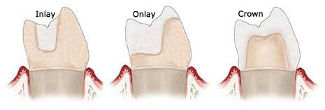 Inlays and onlays are often used when over 1/2 of a tooth’s biting surface is compromised and a durable repair is required. Sometimes referred to as partial crowns, these are considered a more conservative means of tooth restoration.
Inlays and onlays are often used when over 1/2 of a tooth’s biting surface is compromised and a durable repair is required. Sometimes referred to as partial crowns, these are considered a more conservative means of tooth restoration.
What are inlays and onlays?
Inlays and onlays can be made of porcelain, gold, or composite resin and are fabricated in a dental lab. These pieces are bonded to the damaged area of the tooth. An inlay, which is similar to a filling, is used inside the cusp tips of the tooth. Similar to a crown, an onlay is a more extensive reconstruction than an inlay, but extends out over one or more of the cusps of the tooth.
Historically, gold was the material of choice for inlays and onlays. However, in recent years due to its strength and color, porcelain has become increasingly popular. It is obviously a superior match to the natural color of teeth over gold.
How are inlays and onlays applied?
Due to labwork that is required, inlays and onlays require two appointments to complete the procedure. During the first visit, the filling being replaced or the damaged/decayed portion of the tooth is removed, and the tooth is prepared for the inlay or onlay. An impression of the tooth is taken to ensure proper fit and bite. Based on the impression the lab fabricates the inlay or onlay. Before conclusion of the first visit, a temporary sealant is applied to the tooth.
At the second appointment, the first requirement is to remove the temporary sealant. The doctor will then “dry fit” the inlay or onlay to be sure it fits correctly. If the fit is satisfactory, the inlay or onlay will be bonded to the tooth with a strong composite resin and then polished to a smooth finish.
Considerations to keep in mind with Inlays and Onlays
Traditional fillings can reduce the strength of a natural tooth by up to 50% due to the undercuts needed to create a mechanical bond between the tooth and the metal amalgam. As an alternative, inlays and onlays, being bonded directly onto the tooth using special high-strength composite resins, can actually increase the strength of a tooth by up to 75%. As a result, teeth that have been restored with inlays and onlays can last from 10 to 30 years. In cases where the damage to the tooth is not extensive enough to merit an entire crown, onlays can provide a very good alternative. The Govers will be happy to consult with you on alternatives for cosmetic and restorative dentistry, including inlays and onlays.
